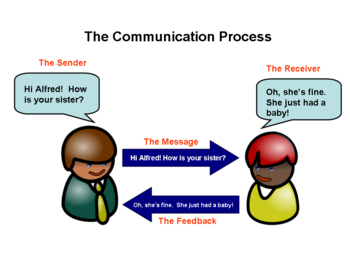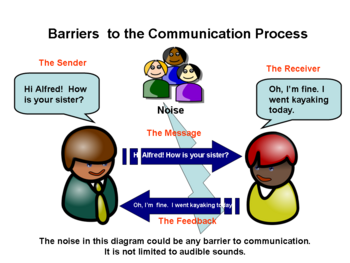Life Skills Development/Module Three/Unit 1: The Approach to Communication/Barriers
Contents
BARRIERS TO COMMUNICATION
Content
Each learner comes from a different background, with their own values as influenced by the physical or cultural context. It is important that you are aware of these differences as they may hinder the comunication process.
|
Learners should be able to:
|
|
1.Barriers to Communication - forms or factors which prevent communication from taking place 2.Hindrances - cultural, physical, mental or emotional barriers which impede the effective flow of communication 3.Diversity - variety or range of characteristics 4.Context - situation / framework or circumstance in which communication occurs 5.Prejudice - bias, preconceived notion / conclusion 6.Connotative - special meaning attached to word or phrase by a specific group 7.Linguistic - different language 8.Perceptual - viewing what was said from one's own perception or point of view |
Barriers to Communication includes a range of physical, mental or emotional hindrances which can prevent messages from being passed on successfully between sender and receiver during the process of communication. Examples of these barriers include language,physical, emotinal, mental, cultural, situational, contextual and experiential. Recognition of these barriers will facilitate selections of appropriate techniques or strategies that are needed for overcoming them and or for making improvement in the process.
Physical Barriers
Physical barriers concerns with ranges of hindrance or obstruction that might occur anywhere along the channel/line of communication beginning from the sender to the reciever to block off of the actual intention of the message. These physical barriers may include physical object, noise from a passing trafic, disruptions such as two people talking as the same time, distance from which the call is made from, mechanical or technical faults or amfuctions, feeling unwell like being too sick or stressout or secondary or third person relaying the message.
Mental and Emotional Barriers
The mental, emotional, psychological state of the learner may also affect the way the message is conveyed or interpreted. These situations may result from:
- emotional stress
- anger
- depression or sadness
- too much informations or too little or inaccuracy of information
- a distorted and subjective focus in your message
- lnsecurity or lack of confidence
- difficult personalities you may encounter
Cultural Differences
As a learner from a different origin, your interaction with your group may impact how you communicate due to the difference in cultural and social class or sub-groups. Awareness of the customs, values and traditional beliefs of the group is very important as these may affect the success of your intended communication with them. There can be personal biases, social prejudices based on political, ethnic and religious beliefs and generalized perceptions and stereotyping others.
Language Barriers
As a learner it is of paramount importance that you make it your responsibility to accommodate language differences and find a common ground within which the group can learn. Some words can have more than one meaning given the specific contextin which it is being used. Some learners language for learning may be his/her own language or even be a second language of learning e.g. English, French. Use of incorrect terminologies or mis-spelt words may lead to incorrect conveying of information.
Contextual Barrier
The context in which words are used by one person may be different from the context in which such words are used by another. These could be influenced by morals, values or culture among other things.
Experiential Barrier
An individuals prior experiences in encountering some words or expressions could affect how they respond to similar messages in the future.
Situational Barrier
The prevailing situation at the time of the sending and receiving of the message may influence the process.
| dramatizing language barrier
1.A French-speaking family arrives in Trinidad from Martinique and is immediately thrown into situations reflecting differences in culture including language, forms of greetings etc. Problems include interaction with
role playing: lack of focus and noise as barriers to communication Father (single parent) and teenaged sons (background noises including music from CD player) Father is packing to leave on a business trip and reminding his sons about guidelines for visitors to the house; securing the house at night (Young men are playing hand-held computer games while listening to their father). Scene 11: Brothers are arguing about the guidelines, since they are organizing a party.
|
|
Communication is unsuccessful when there is a breakdown between the sender and the receiver. The breakdown occurs when there is a barrier to the communication process, resulting in misunderstandings and sometimes frustration. These barriers can be physical or cultural and include distractions, overpowering emotions, lack of clarification, improper feedback, as well as a difference in perception. Effective communication takes place when there is a common understanding and acceptance of the message between the sender and receiver. |
|
How will I assess my progress You will be assessed through Self and Peer assessment 1. Disscuss with another learner an unsuccessful communication situation in which you found yourself. Consider reasons why communication was not successful. List the hindrances/barriers which made communication difficult or unsuccessful and show how this may have impacted on your interpretation of information recieved. Identify the type of barrier you would like to change. Share your personal insights with each other, then choose techniques for improving this barrier, to present to the larger group. Preferably a role play,no more than ten minutes. Suggest strategies, make recommandations for improvements. |
|
Can I identify the barriers to communication? Reflect on the barriers I encounter during communication How do I deal with such barriers to communication Reflect on emotional barriers and what strategy to be used to overcome them your expectations of others, self or organization a barrier are others aware of your expectations? |
Peer assessment Presentations, discussions and dramatizations
Based on the types of barriers discussed in the session paragraphs above, share any of your personal experiences where you were unable to send intended message.state what the barriers is and show in the image at which point in the communication process the problem may have occur. then identify an appropriate strategy of how you would go about preventing the problem from occuring again.
images1.
image2.
|
Look at the 2 images above and answer the guestions that follows:
|
image3
consider the method of communication as demonstrated by the image and explain the context
supportive materials
- Handouts
- Videos
- Skits
- Power point presentation
- Comics
- Animations


